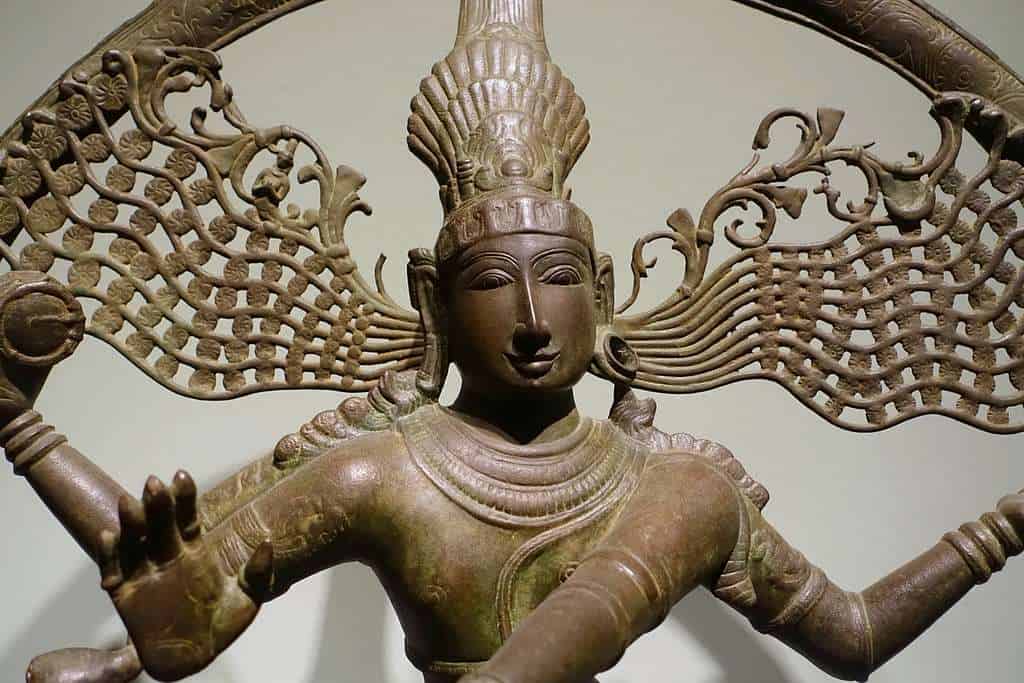Historic Indian arts that reflects divine artistry, royal patronage, and living traditions across metal, paint, and textile.

Among India‘s most enduring legacies is the intricate, expressive language of its handcrafted art that captures the soul of civilisations long gone, still alive in the hands of skilled artisans. Here are nine iconic Indian art forms that have stood the test of time, even as pressures are reshaping the environment in which these traditions once flourished.
Chola Bronze
The legacy of Chola bronze sculptures stands as one of South India’s most remarkable artistic achievements. Flourishing between the 9th and 13th centuries CE under the reign of the Chola dynasty, these bronzes reflect a golden era of Tamil art, architecture, and temple culture. The Chola rulers were devoted patrons of Hinduism, particularly in the worship of Lord Shiva and Vishnu, commissioning countless temples and sanctifying them with intricately cast bronze deities.
The bronzes were created using the ancient lost-wax casting technique, known as cire-perdue. This involves sculpting a detailed figure in wax, encasing it in layers of clay, and then heating the mould so that the wax melts and leaves a hollow space. Molten bronze was then poured into this cavity. Once cooled, the clay covering was broken open to reveal a unique and finely detailed sculpture. The technique demanded extraordinary precision and artistry, allowing the finest embellishments to emerge.
These sculptures were not simply objects of beauty. They were revered as sacred manifestations of the divine. The most iconic among them is the Nataraja, depicting Lord Shiva in his cosmic dance, symbolising the eternal cycle of creation and dissolution. Far from static images, these bronzes played an active role in temple rituals. They were bathed, adorned with clothes and jewellery, and carried in processions during festivals, affirming the living presence of the deity.
Chola bronzes combine artistic grace and technical mastery. Their fluid lines and expressive features convey a sense of movement and devotion that transcends time. They also mirrored the political and cultural priorities of the era, with kings using temple art to reinforce their authority and unite their people. Even today, these masterpieces continue to influence contemporary artists and remain a profound symbol of South India’s enduring spiritual and artistic legacy.
Kutch Silver
In the sun-scorched expanse of Gujarat’s Kutch region, where the landscape is defined by desert winds and resilient communities, a shimmering tradition of silver craftsmanship has flourished for centuries. Known for its intricate filigree work, Kutch silver represents a fusion of artistry, identity, and cultural pride, shaped as much by the harsh environment as by generations of skilled artisans.
This craft involves twisting and curling fine silver wires into delicate lace-like patterns. The wires are then soldered onto a silver base using traditional methods such as repoussé, where the design is raised by hammering from the reverse side, and chasing, which adds detail from the front. The result is a piece that reflects both ornamental beauty and practical design. Kutch artisans apply these techniques to a wide range of items, including jewellery, trays, boxes, and ceremonial artefacts.
Motifs often draw inspiration from local flora, fauna, and geometric patterns, each carrying layers of meaning tied to social customs and regional identity. Over time, trade with Persian, Arab, and Central Asian regions introduced new styles and techniques, which blended seamlessly with local traditions to create a distinctive design vocabulary.
The art has survived through oral transmission and apprenticeship, with silversmith families passing their expertise and stories through generations. Despite pressures of industrialisation and changing consumer tastes, Kutch silversmiths continue to evolve while staying rooted in tradition. Today, their work is admired not only in India but also across the world, celebrated for its meticulous detail and cultural richness. Kutch silver remains a living legacy of craftsmanship, resilience, and the enduring spirit of Gujarat’s artisan heritage.
Bidriware
Bidriware is a metal craft that traces its origins to the city of Bidar in Karnataka, dating back to the 14th century during the reign of the Bahmani Sultanate. This elegant art form found its greatest refinement under the patronage of the Mughals, who embraced its beauty and fostered the blending of Persian and Indian design traditions. What makes Bidriware truly distinctive is its dramatic visual contrast: luminous silver inlay set against a rich, blackened metal base.
The core material used in Bidriware is an alloy of zinc and copper, cast into objects such as vases, trays, plates, hookahs, and decorative boxes. The black finish is not achieved through paint but through a chemical oxidation process. Artisans apply a special paste made of soil rich in manganese to darken the surface. This enhances the shine of the silver inlays while giving the background its characteristic matte black appearance. Precision is vital, as the process must retain the delicate integrity of the inlaid designs.
Symbolically, Bidriware captures the artistic spirit of the Deccan, uniting elements of Hindu and Islamic traditions. Its motifs range from lotus blossoms, creepers, and vines to arabesques and Persian calligraphy. These designs reflect a centuries-old cultural dialogue, with influences flowing between local craftspersons and Persian artisans who brought new aesthetics and techniques to the region.
Bidriware has been sustained through generations of skilled families who have passed down both the knowledge and the cultural significance of the craft. Despite the rise of machine-made alternatives, Bidriware endures as a symbol of technical finesse and artistic depth. Today, it is admired globally for its heritage, craftsmanship, and the unique visual charm that continues to speak of the Deccan’s rich and layered past.
Meenakari
Meenakari is one of India’s most exquisite decorative arts, known for its vivid colours, intricate detail, and regal charm. This refined technique of enamelling flourished in India between the 16th and 18th centuries, particularly under the Mughal emperors and Rajput royalty. Its roots lie in Persia, where metal enamelling had been practised for centuries. When Persian artisans arrived in India, their skills found a new home under imperial patronage, blending seamlessly with Indian craftsmanship to form the distinctive Meenakari tradition.
The word “Meenakari” derives from the Sanskrit “Meena”, meaning enamel or paradise, a fitting tribute to the art’s celestial appeal. The process involves carefully applying powdered coloured glass onto metal surfaces, typically gold, silver, or copper. These pieces are then fired in high-temperature kilns, allowing the enamel to fuse and produce a smooth, glossy finish. Artisans use this method to create detailed floral motifs, geometric patterns, and mythological scenes, all brought to life with vibrant colour and precision.
Meenakari reached the height of its refinement during the Mughal era. It adorned everything from jewellery such as necklaces, bangles, and earrings to ceremonial weaponry, perfume containers, and decorative boxes. The art symbolised wealth and nobility, and Meenakari pieces were often included in royal trousseaus as symbols of status, luxury, and beauty.
Over generations, the Meenakari tradition has been preserved by skilled families of craftsmen, especially in Jaipur and Ahmedabad. These artisan communities have safeguarded their ancestral knowledge while continuing to adapt the designs for contemporary tastes. Today, Meenakari remains as alluring as ever, with its dazzling colours and intricate patterns finding place in modern fashion and design. As both a symbol of India’s imperial past and a flourishing living tradition, Meenakari continues to shine as a jewel of heritage and craftsmanship.
Pahari Paintings
Nestled in the tranquil hill states of Himachal Pradesh and Uttarakhand, the tradition of Pahari painting blossomed between the 17th and 19th centuries. These paintings emerged in princely courts such as Kangra, Guler, Basohli, and Chamba, where Rajput rulers actively supported the arts as a means to express devotion, celebrate royal grandeur, and affirm cultural identity.
Rooted in Hindu mythology and the spiritual fervour of the Bhakti movement, Pahari paintings vividly depict episodes from the Ramayana and Mahabharata, alongside lyrical tales of Lord Krishna and Radha. These works are admired for their brilliant colours, intricate brushwork, and the gentle expression of divine emotion and romance. Each painting tells a story, infusing narrative with a sense of serenity and grace that mirrors the natural beauty of the Himalayan landscape.
The style draws from various artistic traditions. While pahari painting incorporates the refined detailing and realism of Mughal miniature painting, it remains firmly grounded in local aesthetics, folk traditions, and mountainous symbolism. Artists used natural pigments made from minerals and plants, which added to the texture and richness of the compositions.
Beyond mythology, Pahari paintings offered a glimpse into royal life, portraying courtly scenes, festive gatherings, hunting expeditions, and village rituals. Each regional school brought its own flair: Basohli favoured bold lines and strong colours, while Kangra introduced softer contours and naturalistic scenery, often imbued with poetic charm.
Today, Pahari paintings continue to be celebrated as visual testaments to the spiritual, cultural, and artistic legacy of the Himalayan kingdoms. Revered by collectors, scholars, and contemporary artists alike, these masterpieces open a window into a world where devotion, storytelling, and nature converge on a delicate sheet of paper.
Mysore and Tanjore Paintings
Among the most revered classical art forms of South India, Mysore and Tanjore paintings are visual expressions of devotion, tradition, and royal patronage. Though they share a spiritual foundation and regional roots, each style carries its own distinct aesthetic and historical evolution.
Mysore paintings trace their lineage to the Vijayanagara Empire, a flourishing centre of art and culture between the 14th and 17th centuries. After the fall of this empire, the Wodeyar rulers of Mysore continued to support the tradition, allowing it to reach its artistic peak in the 18th and 19th centuries. Painted on silk or paper, Mysore paintings are known for their delicate brushwork, refined lines, and soft, muted colours. The themes often revolve around deities such as Vishnu and Shiva, depicted according to classical iconographic rules. These paintings embody serenity and grace, drawing heavily from South Indian temple traditions and sacred texts.
Tanjore paintings, on the other hand, originated in Thanjavur, Tamil Nadu, during the 16th century under the Nayaka rulers, later thriving under the Marathas. This style is instantly recognisable for its use of rich colours, gold leaf, and glass inlays, creating a three-dimensional, gem-like effect. Tanjore paintings usually feature central figures of Hindu gods such as Krishna, Rama, and Lakshmi, often portrayed within scenes from the epics. With bold outlines and symmetrical compositions, they were traditionally crafted as temple icons, intended to inspire worship and enhance the sanctity of sacred spaces.
Both traditions continue to thrive through dedicated artisan communities and art schools. Revered for their devotional significance and aesthetic brilliance, Mysore paintings and Tanjore paintings preserve South India’s rich heritage while continuing to inspire contemporary interpretations of sacred art.
Dhokra Metal Casting
Dhokra metal casting is among India’s oldest surviving art forms, with roots extending more than 4,000 years to the Indus Valley Civilisation and earlier prehistoric times. It represents an extraordinary continuity of ancient metalworking, sustained through generations by tribal communities in West Bengal, Odisha, and Jharkhand. What makes Dhokra truly remarkable is its enduring use of the lost-wax casting technique, which remains largely unchanged to this day.
The process begins with artisans sculpting detailed wax models of their intended designs. These are layered with fine clay to form a mould. Once heated, the wax melts away, leaving behind a cavity that is filled with molten metal, usually a bronze alloy. After cooling, the outer shell is broken to reveal a hollow sculpture, each piece unique in form and character.
Dhokra figures are known for their rustic charm and expressive features. They often depict tribal deities, animals, village scenes, and symbols inspired by nature, such as birds, trees, and the sun. These motifs are not merely decorative. They reflect the community’s beliefs, rituals, and its deep-rooted connection with the natural world.
The art has served both sacred and practical purposes. Dhokra objects were traditionally used in rituals, festivals, and daily life, acting as protective talismans or symbols of social status. Over time, the aesthetic and cultural value of Dhokra has drawn appreciation from across the world, with collectors and art enthusiasts recognising it as a powerful expression of India’s tribal heritage.
Despite modern pressures, Dhokra continues to thrive through the commitment of artisan families. They preserve traditional forms while experimenting with contemporary themes, ensuring that this ancient craft remains both a living tradition and a vibrant cultural voice.
Zardozi Embroidery
Zardozi embroidery is one of the most opulent and intricate forms of needlework in India, with a legacy that traces back to ancient Persia. The term “Zardozi” comes from the Persian words zar – meaning gold, and dozi – meaning sewing, a fitting description for this glittering art. Introduced to India during the Mughal era, between the 16th and 18th centuries, Zardozi quickly gained favour in royal courts, where it became a symbol of power, luxury, and divine grandeur.
This craft involves hand embroidery using real gold and silver threads, often enhanced with pearls, beads, sequins, and precious stones. Artisans work these materials into rich fabrics such as silk, velvet, and satin to create elaborate motifs. Common patterns include florals, paisleys, vines, and symmetrical geometric shapes, all of which reflect a refined aesthetic rooted in both Persian and Indian traditions.
Under Mughal patronage, and later supported by the Nawabs of Awadh and Hyderabad, Zardozi flourished in cultural centres like Lucknow, Delhi, and Hyderabad. Each region developed its own interpretation. Lucknow became known for fine, intricate stitching, while Hyderabad embraced a more ornate, heavily embellished style.
Zardozi was used to embellish ceremonial robes, turbans, shoes, and accessories, as well as home décor items such as wall hangings and cushions. The embroidery also played an important role in religious and ceremonial attire, reflecting its spiritual and cultural significance.
Today, Zardozi remains a revered craft upheld by artisan families who continue to pass down their knowledge. Contemporary designers have embraced the tradition, incorporating Zardozi into bridal couture and high-end fashion, ensuring its relevance in today’s creative landscape. It stands as a timeless celebration of craftsmanship, heritage, and regal artistry.
Tanjore Dolls
Tanjore dolls, also known as Thanjavur thalayatti bommai, are among Tamil Nadu’s most iconic folk crafts. Originating in the historic town of Thanjavur, this cherished art form has delighted generations with its graceful motion, festive charm, and cultural symbolism. With a lineage believed to stretch back several centuries, the dolls reflect the vibrant artistic traditions fostered by the Chola dynasty and later South Indian rulers, who actively supported dance, music, and temple celebrations.
Each doll is handcrafted using locally sourced clay, which is shaped, fired, and painted in vivid natural colours. Their most distinctive feature is the gentle bobbing motion of the head or body, created through a rounded, weighted base. When touched, the doll wobbles rhythmically, evoking a sense of dance. This movement is more than a visual delight. It symbolises joy, festivity, and auspiciousness, making the dolls especially popular during Navaratri, a festival dedicated to the Divine Feminine.
Tanjore dolls portray a wide variety of characters, including mythological figures, classical dancers, musicians, and rural scenes. The depictions often echo the elegance of Bharatanatyam and traditional Carnatic music, capturing the cultural soul of Tamil Nadu. Each figure tells a story, not just through form, but through gesture, attire, and colour.
The knowledge of doll-making has been passed down through generations of artisan families, who have preserved the techniques and spiritual meanings behind this craft. Despite shifts in modern taste and mass production, these dolls continue to be revered. Today, they occupy spaces far beyond festive shelves, finding pride of place in art galleries and private collections. With their blend of movement, craftsmanship, and cultural storytelling, Tanjore dolls remain joyful ambassadors of Tamil Nadu’s living folk heritage.
Read More: Latest



